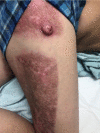Rapid development of squamous cell carcinoma at a split-thickness skin graft donor site
- PMID: 37736031
- PMCID: PMC10509539
Rapid development of squamous cell carcinoma at a split-thickness skin graft donor site
Abstract
The development of a Marjolin ulcer at the site of a split-thickness skin graft donor site is exceptionally rare. Here we describe the rapid development of squamous cell carcinoma at a split-thickness skin graft donor site in the setting of severe burn. We present a case of a 52-year-old male with no past medical history who presented with a 24% total body surface area burn caused by a flash flame. Four months after his initial excision and grafting, he presented for revision of a burn scar with an additional complaint of a rapidly developing skin lesion at his donor site, which arose over 2 weeks. The lesion was excised en bloc and found to be invasive squamous cell carcinoma. There are 5 previous cases of squamous cell carcinoma development at the site of split-thickness skin harvest in the setting of severe burn. While the typical Marjolin ulcer has a latency period of up to 30 years, lesions that arise in split-thickness skin graft donor sites appear to have a rapid onset of weeks to months. Squamous cell carcinoma at the site of split-thickness skin grafting is an uncommon but important sequelae of burn care.
Keywords: Squamous cell carcinoma; burn; donor site.
IJBT Copyright © 2023.
Conflict of interest statement
None.
Figures
Similar articles
-
Squamous Cell Carcinoma at Split Thickness Skin Graft Donor Site: A Case Report and Review of the Literature.J Burn Care Res. 2023 Jan 5;44(1):210-213. doi: 10.1093/jbcr/irac137. J Burn Care Res. 2023. PMID: 36165213 Review.
-
New onset squamous cell carcinoma in previous split-thickness skin graft donor site.Int J Surg. 2018 Apr;52:16-19. doi: 10.1016/j.ijsu.2018.01.047. Epub 2018 Feb 10. Int J Surg. 2018. PMID: 29438815
-
Acute development of invasive squamous cell carcinoma in a split-thickness skin graft donor site.J Burn Care Rehabil. 1998 Sep-Oct;19(5):382-5. doi: 10.1097/00004630-199809000-00004. J Burn Care Rehabil. 1998. PMID: 9789170
-
The Use of Esterified Hyaluronic Acid Matrix in the Setting of a Large Marjolin Ulcer Excision and Reconstruction: A Case Report.Cureus. 2025 Jan 15;17(1):e77454. doi: 10.7759/cureus.77454. eCollection 2025 Jan. Cureus. 2025. PMID: 39958059 Free PMC article.
-
Three cases of malignant melanoma arising on burn scars.J Dermatol. 2003 Aug;30(8):617-24. doi: 10.1111/j.1346-8138.2003.tb00445.x. J Dermatol. 2003. PMID: 12928532 Review.
Cited by
-
Squamous cell carcinoma arising in a below-knee stump of a patient with chronic lymphocytic leukemia.J Vasc Surg Cases Innov Tech. 2024 May 21;10(4):101537. doi: 10.1016/j.jvscit.2024.101537. eCollection 2024 Aug. J Vasc Surg Cases Innov Tech. 2024. PMID: 38989265 Free PMC article.
References
-
- Sharma A, Schwartz RA, Swan KG. Marjolin’s warty ulcer. J Surg Oncol. 2011;103:193–195. - PubMed
-
- Kowal-Vern A, Criswell BK. Burn scar neoplasms: a literature review and statistical analysis. Burns. 2005;31:403–413. - PubMed
-
- Shah M, Crane JS. Marjolin ulcer. In: StatPearls [Internet] Treasure Island (FL): StatPearls Publishing; 2023. Available from: https://www.ncbi.nlm.nih.gov/books/NBK5-32861/ - PubMed
-
- Haik J, Georgiou I, Farber N, Volkov A, Winkler E. Squamous cell carcinoma arising in a split-thickness skin graft donor site. Burns. 2008;34:891–893. - PubMed
-
- Hammond JS, Thomsen S, Ward CG. Scar carcinoma arising acutely in a skin graft donor site. J Trauma. 1987;27:681–683. - PubMed
Publication types
LinkOut - more resources
Full Text Sources
Research Materials
Miscellaneous

